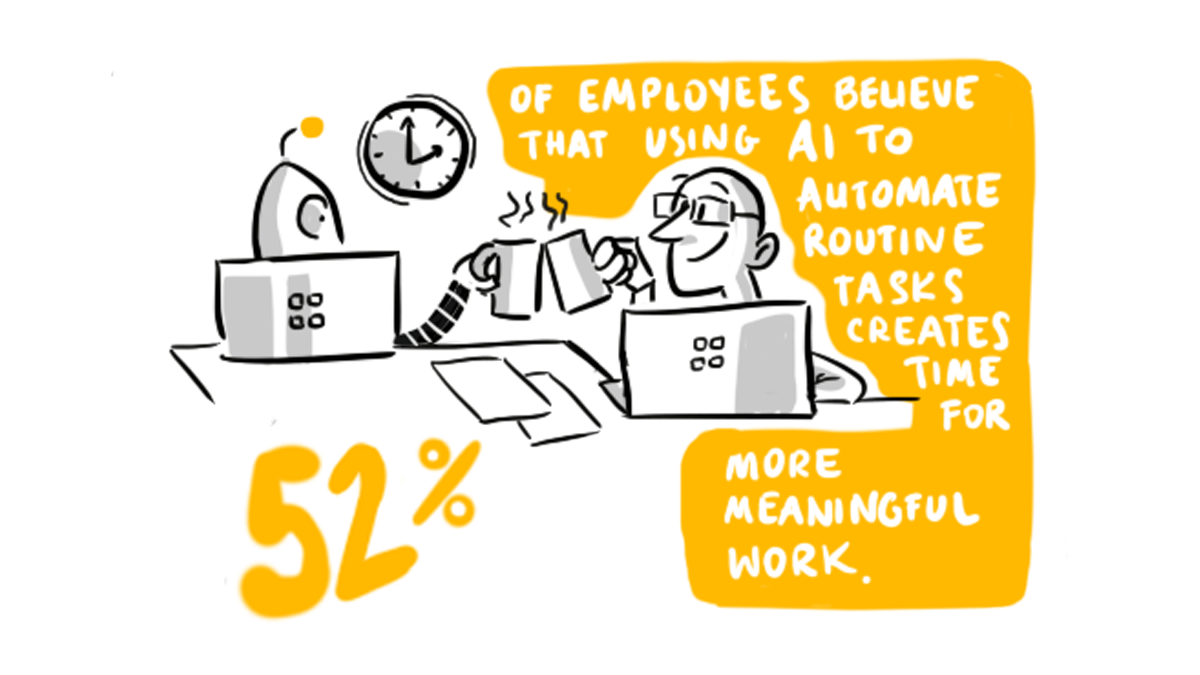
Four skills you need to succeed in 2019
How many skills are there in the professional world? About 50,000, according to LinkedIn.[1] And as technology grows, so will that number. Maintaining and developing skill sets are important for individuals and businesses alike. Skilled employees are 8.4 percent more productive and 70 percent of employees indicated that job-related training and development opportunities influenced their decision to stay at their job.[2]
Technology is interwoven in every part of our life and changing the very nature of the jobs we do. Within the next two decades, over 90 percent of jobs will require some form of digital proficiency, opening up new demands in job roles now and in the future. 79 percent of UK leaders believe it’s worth investing in re- or upskilling their current workforce. On the flip side, only 18 percent of UK workers are actively learning new skills to help them keep up with these changes.

There’s clearly a growing skills gap in the UK, and we need to ensure everyone is confident in both their soft and technical skills in order to succeed. If there are over 50,000 skills out there, which ones should employees and organisations focus on this year?
1. Working with and alongside AI
One of the biggest drivers of change is AI. Not just for data scientists and IT professionals, AI will affect everyone; and it’s important you and your employees understand how to leverage it for good.
AI is already transforming industries, making us more productive, and helping to solve some of the world’s biggest challenges. It’s also among the fastest growing skills on LinkedIn[3]. However, according to the World Economic Forum (WEF), 54 percent of employees will need significant re- and upskilling.[4]
At the moment, AI is being used across industries to deliver better business outcomes, improve customer experience, and drive productivity. For instance, a chatbot will answer common customer questions and transfer them to an employee if the questions become more complicated. This frees up staff to spend more time on complex matters and the things that require a more human response.
In healthcare, AI can be used to help provide more cost-effective, personalised treatment by automating elements of what have been historically task-heavy processes, such as referrals.[5] Financial services also benefit from better fraud detection and data processing to drive better outcomes. Whilst in education, AI can be used to help provide more personalised learning experiences and give valuable time back to teachers.
And it’s already starting to prove its ROI – organisations on their AI journey are delivering 5% better business outcomes than those who aren’t. – Maximising the AI opportunity, Microsoft UK
Tip: We’ve got resources to help you and your employees get the most from AI – whether you want to increase productivity or create a stronger customer experience.

2. Understanding the cloud
If you haven’t moved to the cloud yet, you’re probably either in the process or planning to make the move. In fact, 96 percent of respondents to the RightScale 2018 State of the Cloud [6]survey use the cloud. Due to this shift, there’s greater demand for cloud-skilled employees. It’s more than just having IT knowledge or a cloud expert in your IT team. By understanding the fundamentals of cloud and what it means for your organisation, you can leverage the best of the technology while ensuring your data remains secure.
Understanding how to use the cloud will help you be more productive, collaborative, and agile. To achieve successful digital transformation, it’s essential to grow your understanding of technology and how to embed digital in your strategic planning.
Tip: Every business can benefit from the cloud. Develop your cloud skills no matter if you’re an employee, business leader, or IT professional.
3. Analytical thinking
Technology has made our lives easier. Thanks to AI, we’re collecting and have access to vast amounts of information to help us make better, more informed business decisions[7]. As a result, organisations need people who can make smart business decisions based from this information.
Analytical thinking is when you use facts and information to identify the strengths and weaknesses of approaches to problems. It’s used to brainstorm, solve complex problems, and make informed decisions across job roles – especially those relating to data.
According to the WEF, analytical thinking will be the top growing skill in 2022[8]. When we consider how humans and AI will increasingly work together, analytical thinking will be vital to unleash the full power of this collaboration.
Tip: Data is fast becoming the currency of business. Improve your big data skills and learn how to analyse and visualise data to create stronger business outcomes.
4. Soft skills
Being digitally savvy isn’t the only requirement. You also need to know how to use these skills, when to use them, and what to use them for. According to the WEF, soft skills are more in demand than ever before. 57 percent of senior leaders today say soft skills are more important than hard skills. [9]After all, robots can easily sort through masses of data. But they don’t have the innate, softer skills such as creativity, teamwork, and problem-solving we humans have. Best of all, these skills are transferable across roles meaning they’re helping future proof the workforce.
According to research by Microsoft and YouGov, 62 percent of British workers define creativity as solving a problem in a new way. As process-driven tasks are shifted over to AI and machines, the ability to innovate and stand out from the crowd is becoming increasingly important.
“Creativity is at the heart of business innovation, and innovation is the engine of growth.” – McKinsey research
In fact, creativity can separate successful organisations from the rest. McKinsey found that creative organisations outperformed others in both innovation and financial performance.[10] The Adobe State of Create survey says that businesses that invest in creativity have a 78 percent increase in productivity and 76 percent happier employees.[11] We’re encouraging creativity from an early stage with our Maker Champions projects, letting children explore their creativity alongside computing and engineering.
Tip: 23 percent of employees believe a work environment that offers a mix of diverse spaces that foster collaboration, socialisation, and focussed work would boost creativity. Find out how to foster creativity in your workforce.

Take action: Invest in your digital skills
Organisations that have a culture of learning and collaboration, where employees have the technical knowledge and the opportunity to take risks, tend to outperform those who don’t by 10 percent. Employees who are active learners are more productive and empowered.
In a world being transformed by technology, developing yours and your employees’ digital skill set is more important than ever. We all have a responsibility to address the skills gap in the UK and build our workforce of the future. This is why we created our Digital Skills programme – a range of free courses, training resources, and guides to support business leaders and employees in the UK.
[msce_cta layout=”image_center” align=”center” linktype=”blue” imageurl=”https://www.microsoft.com/en-gb/industry/blog/wp-content/uploads/sites/22/2018/10/Skills-Twitter.png” linkurl=”https://www.microsoft.com/en-gb/athome/digitalskills/” linkscreenreadertext=”Get started with the Digital Skills Programme” linktext=”Microsoft Digital Skills Programme” imageid=”2773″ ][/msce_cta]
[1] https://www.linkedin.com/pulse/skills-companies-need-most-2019-how-learn-them-paul-petrone/
[2] https://www.shiftelearning.com/blog/statistics-value-of-employee-training-and-development
[3] https://learning.linkedin.com/blog/advancing-your-career/the-age-of-ai-is-here–here-s-how-to-thrive-in-it-
[4] http://www3.weforum.org/docs/WEF_Future_of_Jobs_2018.pdf
[5] https://www.microsoft.com/en-gb/industry/blog/industry/health/12-days-ai-christmas-rpa-nhs/
[6] https://info.flexerasoftware.com/SLO-WP-State-of-the-Cloud-2018?campaign=7010g0000016Jhv&utm_content=textlink1
[7] https://www.microsoft.com/en-gb/industry/blog/industry/cross-industry/5-ways-to-bring-your-data-to-life/
[8] http://reports.weforum.org/future-of-jobs-2018/shareable-infographics/?doing_wp_cron=1547717517.4147269725799560546875
[9] https://learning.linkedin.com/resources/workplace-learning-report-2018
[10] https://www.mckinsey.com/business-functions/digital-mckinsey/our-insights/creativitys-bottom-line-how-winning-companies-turn-creativity-into-business-value-and-growth
[11] https://www.adobe.com/content/dam/acom/en/max/pdfs/AdobeStateofCreate_2016_Report_Final.pdf




